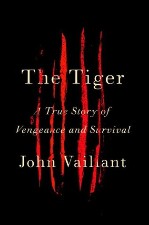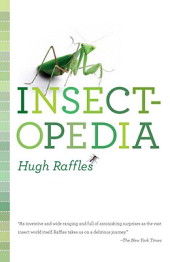 One of those intriguing books about an animal I knew surprisingly little of and a part of the world, eastern Siberia, about which I was completely ignorant. The Tiger is the tale of a singular animal at the end of the 20th century that searches far and wide for one hunter that has done him wrong so he can eat him. In addition to learning how tigers can distinguish and track one human from another for the purpose of avenging past injustices it was equally fascinating to discover eastern Siberia. Here in the forest with winter temperatures routinely forty degrees below zero live both tigers and people abandoned following the demise of the Soviet Union. Survival in the forest is not much different in the year 2000 than it must have been 300 years prior: hunting, gathering wild mushrooms and pine nuts, log huts, and vodka.
One of those intriguing books about an animal I knew surprisingly little of and a part of the world, eastern Siberia, about which I was completely ignorant. The Tiger is the tale of a singular animal at the end of the 20th century that searches far and wide for one hunter that has done him wrong so he can eat him. In addition to learning how tigers can distinguish and track one human from another for the purpose of avenging past injustices it was equally fascinating to discover eastern Siberia. Here in the forest with winter temperatures routinely forty degrees below zero live both tigers and people abandoned following the demise of the Soviet Union. Survival in the forest is not much different in the year 2000 than it must have been 300 years prior: hunting, gathering wild mushrooms and pine nuts, log huts, and vodka.
-
-
Insectopedia by Hugh Raffles ** (of 4)
 It had great promise. An A to Z series of essays on the most numerous, weighty, and least talked about organisms on earth chronicled by a gifted writer. I wish I could have read the whole thing, but Raffles is an anthropologist, not an entomologist. He would begin an essay with an insect story, divert to a person or people pertinent to those insects, say, China’s trained crickets, and then get lost in his own beautiful sentence constructions. In the end this book will probably appeal to those people that like the kind of nature writers who wax poetic and philosophical, but only occasionally remember to tell good stories. It felt like a book written for writers, not readers.
It had great promise. An A to Z series of essays on the most numerous, weighty, and least talked about organisms on earth chronicled by a gifted writer. I wish I could have read the whole thing, but Raffles is an anthropologist, not an entomologist. He would begin an essay with an insect story, divert to a person or people pertinent to those insects, say, China’s trained crickets, and then get lost in his own beautiful sentence constructions. In the end this book will probably appeal to those people that like the kind of nature writers who wax poetic and philosophical, but only occasionally remember to tell good stories. It felt like a book written for writers, not readers. -
Pompeii by Robert Harris ** (of 4)
About the three days before Mount Vesuvius blew its top and decimated the city of Pompeii as seen through the eyes of a conscientious aquarius in charge of trying to figure out why the Roman aqueducts have stopped flowing. An interesting novel since you know how it is going to end, but watching how the Romans begin to uncover the signs of the impending explosion is fascinating.
-
Double Whammy by Carl Hiassen *** (of 4)
Vintage Hiassen. The murderers and bad guys are Florida tele-evangelists and unscrupulous land developers, assisted by rednecks with brains the size of ‘possums. The good guys are a black cop, a cuban detective, an anti-development woodsman with a log cabin full of great books who lives on roasted roadkill animals, and a photographer with a bad temper, but a good heart. It’s like many of Hiassen’s other books. Wonderful parody of Florida’s hucksters. In the end bad things happen to bad people and the reader cares a little bit more about the environment and the victims of racism, sexism, or classism. He’ll make you laugh aloud. October 2006.
-
Young Men and Fire by Norman Maclean **** (of 4)
Norman Maclean is like Roger Angell: an old school Master of wordsmithing. His command of English and of writing is simply superior. Maclean’s first great book, A River Runs Through It, about trout fishing took decades to write. Young Men and Fire is the story of smoke jumpers who get caught in a western canyon fire when the fire reverses and flies up a hill at them with the speed of a tornado. Maclean died before he finished the book so you can tell the last 70 pages aren’t as polished as the first four-fifths of the book. Still, it’s an outstanding read filled with excellent detail presented compellingly.
-
Winter by Rick Bass *** (of 4)
At the age of 29, Bass forsakes his worldly belongings, save for his broken down truck, and leaves Houston for the very limit of the United States, a remote, sparsely inhabited valley in Montana on the edge of the Canadian border. His goal is to explore Yaak, learn about himself, become a writer, and above all else, survive winter. At times he is overcome by self-importance and the self-consciousness of recapitulating Thoreau’s Walden, and at others, he is so observant and elegiac that he can make individual snowflakes or the crack of split wood so important we cannot believe we have never before taken notice. The book’s shining message is the imperative to slow down, escape the drive of modern American life, even if all we do is read his book. January 2007.
-
Walk in the Woods by Bill Bryson **** (of 4)
This was my first Bryson. It’s his description of walking the Appalachian trail. I can think of no other book that made me laugh out loud. This book made me do it several times.
-
Tigers in the Snow by Peter Matthiessen ** (of 4)
Everything you ever wanted to know about tiger life in the wilds of Asia from Siberia to India. Read the book or visit a zoo, because according to Matthiessen tigers are doomed. The book so plainly praises the dignity of wild tigers in their native habitat and the insurmountable threats to their survival I wanted to kill myself I was so depressed. June 2007.
-
The Lost City of Z by David Grann ** (of 4)
Percy Fawcett, one of the last of the iconic British explorers, ca. 1920, khaki get-up, pith helmet, and scraggly beard spends most of a lifetime searching for a purported grand, abandoned city in the Amazon until he finally gets lost never to be heard from again. The author searches for Fawcett and all the other explorers who have searched for Fawcett, but never quite builds much in the way of suspense. Maybe it is because I have spent time in the Amazon, but I was left with an overwhelming sense of despair for the obvious loss of one of the world’s last great ecosystems and the decimation of the natives who live there, a sideline in Grann’s account.
-
The Omnivore’s Dilemma by Michael Pollan **** (of 4)
 Probably not much you do not already know about America’s industrial food chain and the manufactured food we consume at the end of it. You probably also already know the nutritional and environmental benefits of eating local. But, Pollan is still a great read for the deft way in which he weaves what we eat with philosophy, chemistry, history, economics, and the humanizing narrative of the people who provide our food. In typical Pollan fashion, however, the book contains about 20 percent more words than it really needs. May 2009.
Probably not much you do not already know about America’s industrial food chain and the manufactured food we consume at the end of it. You probably also already know the nutritional and environmental benefits of eating local. But, Pollan is still a great read for the deft way in which he weaves what we eat with philosophy, chemistry, history, economics, and the humanizing narrative of the people who provide our food. In typical Pollan fashion, however, the book contains about 20 percent more words than it really needs. May 2009.